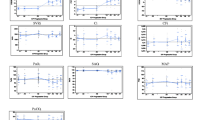Summary
The relationship of jugular venous desaturation and neurological outcome was examined in 116 patients with severe head injury. Seventy-six episodes of jugular venous desaturation were prospectively identified in 46 (40%) of the patients. The etiology of the desaturations varied, including both systemic and cerebral causes. A poor neurological outcome was strongly associated with the occurrence of jugular venous desaturation.
Access this chapter
Tax calculation will be finalised at checkout
Purchases are for personal use only
Preview
Unable to display preview. Download preview PDF.
Similar content being viewed by others
References
Andrews, PJ, Dearden NM, Miller JD (1991) Jugular bulb cannulation: description of a cannulation technique and validation of a new continuous monitor. Br J Anaesth 67: 553–558
Cruz J (1988) Continuous versus serial global cerebral hemometabolic monitoring: applications in acute brain trauma. Acta Neurochir (Wien) [Suppl] 42: 35–39
Cruz J, Miner ME, Allen SJ, et al (1991) Continuous monitoring of cerebral oxygenation in acute brain injury: assessment of cerebral hemodynamic reserve. Neurosurgery 29: 743
Garlick R, Bihari D (1987) The use of intermittent and continuous recordings of jugular venous bulb oxygen saturation in the unconscious patient. Scand J Clin Lab Invest 47 [Suppl 188]: 47–52
Graham DI, Ford I, Adams JH, et al (1989) Ischaemic brain damage is still common in fatal non-missile head injury. J Neurol Neurosurg Psychiatry 52: 346–350
Hans P, Franssen C, Damas F, et al (1991) Continuous measurement of jugular venous bulb oxygen saturation in neurosurgical patients. Acta Anaesthesiol Belg 42: 213–218
Jennett B, Teasdale G, Braakman R, et al (1977) Prognosis in series of patients with severe head injury. Neurosurgery 4: 283
Kohi YM, Mendelow AD, Teasdale GM, et al (1984) Extra-cranial insults and outcome in patients with acute head injury — relationship to the Glasgow Coma Scale. Injury 16: 25–29
Miller JD, Becker DP, Ward JD, et al (1977) Significance of intracranial hypertension in severe head injury. J Neurosurg 47: 501–516
Miller JD (1985) Head injury and brain ischaemia-implications for therapy. Br J Anaesth 57: 120–129
Narayan RK, Greenberg RP, Miller JD, et al (1981) Improved confidence of outcome prediction in severe head injury: A comparative analysis of the clinical examination, multimodality evoked potentials, CT scanning and intracranial pressure. J Neurosurg 54: 751–762
Robertson CS, Contant CF, Gokaslan ZL, Narayan RK, Grossman RG (1992) Cerebral blood flow and outcome after head injury. J Neurol Neurosurg Psychiatry 55: 594–603
Sheinberg M, Kanter JM, Robertson CS, et al (1992) Continuous monitoring of jugular venous oxygen saturation in head-injured patients. J Neurosurg 76: 212–217
Author information
Authors and Affiliations
Editor information
Editors and Affiliations
Rights and permissions
Copyright information
© 1993 Springer-Verlag
About this chapter
Cite this chapter
Robertson, C. (1993). Desaturation Episodes after Severe Head Injury: Influence on Outcome. In: Unterberg, A.W., Schneider, GH., Lanksch, W.R. (eds) Monitoring of Cerebral Blood Flow and Metabolism in Intensive Care. Acta Neurochirurgica, vol 59. Springer, Vienna. https://doi.org/10.1007/978-3-7091-9302-0_17
Download citation
DOI: https://doi.org/10.1007/978-3-7091-9302-0_17
Publisher Name: Springer, Vienna
Print ISBN: 978-3-7091-9304-4
Online ISBN: 978-3-7091-9302-0
eBook Packages: Springer Book Archive




